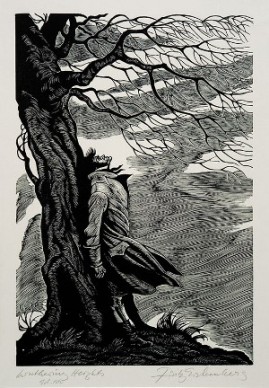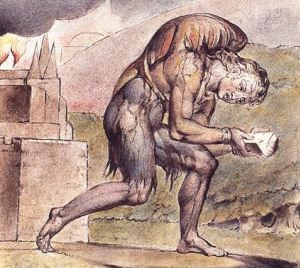

Is a literary term where people's emotions can be likened to the weather
LITOTES
- ironic understatement in which an affirmative is expressed by the negative of its contrary (e.g. I shan't be sorry for I shall be glad ).
Rhyming
couplets are used at the end of sonnets; here’s an example from Shakespeare’s
Sonnet 27:
“Lo,
thus, by day my limbs, by night my mind,
For thee, and for myself, no quiet find
For thee, and for myself, no quiet find
Personification is when
human qualities are attributed to inanimate objects, animals or even abstract
ideas, such as deities. Another word for this is “anthropomorphism”, and human
traits used can include emotions, speech and physical actions. An example is
“the cruel wind” and “The trees seemed to wave us goodbye”
“I make
a great noise
Of rustling all day”
Of rustling all day”
The
word “rustling” is onomatopoeic, reflecting the sound dried leaves make when
they brush gently together; this evocativ
he Dead, with
the alliterative words underlined:
Alliteration“His soul swooned slowly as he heard the snow falling faintly
Alliteration involves the repetition of consonant sounds; they differ from alliteration in that the sounds don’t have to be at the beginning of each word.
8. Metaphor
A metaphor is a type of analogy, used to describe something by comparing it with something otherwise unrelated. A famous example is Shakespeare’s “Shall I compare thee to a summer’s day”, and another is Victor Hugo’s line “Laughter is the sun that drives winter from the human face”, in Les Miserables. Metaphors have long been used for effect; take this example from the Greek philosopher Plato: “…as poets love their poems and fathers their children, just so do money-makers love their money…”.
9. Simile
Pronounced “sim-il-ee”, this term refers to likening something directly to something else, and it’s a form of metaphor used to add colour to writing of any kind – from poetry to novels to songs. You can recognise a simile by spotting the words “as” or “like”. For example, “bright as a summer’s day”. “My love is like a red red rose” is a famous example of a simile, used in the poem of the same name by the 18th century Scottish poet Robert Burns.
10. Aside
An aside is a device that has been used in plays for centuries, involving a character directly addressing the audience without the other characters being able to hear. It’s part of the story, usually kept brief and often used comically to gossip or make a comment about another character behind their back. Some films make use of this technique too, with a character looking directly into the camera to address viewers, known in this context as ‘breaking the fourth wall’. This is something Amelie, the eponymous heroine of the French film that bears her name, does frequently by whispering conspiratorially to the audience.
11. Allegory

‘Christian Reading in his Book’ by William Blake, an illustration for Pilgrim’s Progress. The weight on Christian’s back is the knowledge of his own sin.
An allegory is a kind of story that has a meaning deeper than its obvious one, and it’s a sort of extended metaphor. A famous example is Bunyan’s The Pilgrim’s Progress, which ostensibly tells the tale of the journey of its protagonist Christian, but has a symbolic meaning that describes the journey of a Christian from Earth to Heaven. In Medieval times, allegory was commonly used to communicate religious messages, but later it became a way of commenting on politics or society. Gulliver’s Travels by Jonathan Swift and Animal Farm by George Orwell are both examples of allegories that use bizarre stories as parallels for real political and social situations; Swift was commenting on everything from particular politicians to entire countries, while Orwell’s tale reflects events in the run-up to the 1917 Russian Revolution.
12. Hyperbole
Pronounced “hipe-ER-bowl-ee”, this term comes from a Greek word meaning “excess” and describes exaggeration used for rhetorical effect. It’s not meant to be taken literally, but it is used to make a point particularly forcefully. We often use it in everyday language, for example “I’ve told you a million times” or “I love you to the moon and back”. Hyperbole is often used in literature, such as in the celebrated 20th century Colombian writer Gabriel Garcia Márquez’s Living to Tell the Tale, in which he writes: “At that time Bogota was a remote, lugubrious city where an insomniac rain had been falling since the beginning of the 16th century.” Clearly he doesn’t literally mean that it hasn’t stopped raining since the 16th century; he’s just exaggerating to show readers that it’s somewhere in which a lot of rain falls!
13. Connotation
A word that conjures up other meanings or sparks thoughts of something else has “connotations”. For example, the word “white” has connotations of purity, peace, good, innocence, and cleanliness. Writers often choose certain words because they know that readers will associate them with other things, and they can enrich writing with many layers of meaning. An example of connotations used in literature is George Orwell’s Animal Farm, in which certain animals have been chosen for particular characters because of the connotations those animal species have. This applies most especially to the pigs, who are powerful and corrupt, playing on the idea of “greedy pigs”. Another example is Boxer the workhorse, who represents labourers; the image of the working horse has connotations of working the land, going out and doing an honest day’s work, physical labour and so on. These associations help heighten the effectiveness of the allegory in this memorable and influential novel.
14. Stream of consciousness
This literary technique describes a character’s interior monologue: a continuous flow of thoughts going on in the character’s mind. It’s a technique that came to the fore in the 20th century, famously championed by Virginia Woolf in To The Lighthouse and, more bafflingly, by James Joyce in his groundbreaking novel Ulysses, in which the idea of a stream of consciousness is taken to its extreme. Trying to represent the randomness of human thought processes literally, Joyce penned paragraphs like this:
“My missus just got an. Reedy freckled soprano. Cheesparing nose. Nice enough in its way: for a little ballad.”
If you’re currently trying to learn English or develop your existing skills, we suggest you might want to avoid Ulysses for the time being!
IRONY
1. In Shakespeare's Romeo and Juliet, the audience/reader knows that Juliet has faked her death, but Romeo does not and he thinks she is really dead. (dramatic irony)
Sarcasm is an ironic or satirical remark that seems to be praising someone or something but is really taunting or cutting. Sarcasm can be used to hurt or offend or can be used for comic affect
.
IRONY
1. In Shakespeare's Romeo and Juliet, the audience/reader knows that Juliet has faked her death, but Romeo does not and he thinks she is really dead. (dramatic irony)
1. There are roaches infesting the office of a pest control service.
2. A plumber spends all day working on leaky faucets and comes home to find a pipe has burst in his home.
sARCASM
Sarcasm is an ironic or satirical remark that seems to be praising someone or something but is really taunting or cutting. Sarcasm can be used to hurt or offend or can be used for comic affect
.
- ’m trying to imagine you with a personality.
- I work 40 hours a week to be this poor.
- Is it time for your medication or mine?
- Well, this day was a total waste of makeup.
- Whatever kind of look you were going for, you missed.
- Not the brightest crayon in the box now, are we?
Satire commonly takes the form of mocking politicians. Consider the following examples of political satire.
Satire in Literature
Satire of Mark Twain
Satire can be found in literature as well. Consider the following explanation about satire in The Adventures of Huckleberry Finn:
The Adventures of Huckleberry Finn was written shortly after the Civil War, in which slavery was one of the key issues. While Mark Twain's father had slaves throughout his childhood, Twain did not believe that slavery was right in anyway. Through the character of Jim, and the major moral dilemma that followed Huck throughout the novel, Twain mocks slavery and makes a strong statement about the way people treated slaves. Miss Watson is revered as a good Christian woman, who had strong values, but she is a slave owner in the story. She owns a slave called Jim, who runs away upon hearing that Miss Watson might sell him to New Orleans.
No comments:
Post a Comment